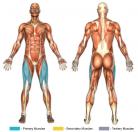Leg Extensions (Machine)
- Adjust the backrest so that your legs can comfortably hang at a 90 degree angle (you want to ensure a full range of motion is possible). Adjust the feet pads so that they meet comfortably with top ankle grooves. Sit. There may be handles available to grasp to hold the torso in place. Grasp, if desired. If there aren't handles, grasping the seat may also work.
- Inhale, raise the lower legs to horizontal by straightening them, exhaling throughout the motion. It is feasible to do these one leg at a time, if desired.
- Slowly allow the weight to lower the legs to the starting position, inhaling throughout the movement.
- Repeat.
All in all, leg extensions are a simple exercise. In virtue of this, they make a congenial exercise for beginners by allowing for the development of a foundation of strength that is necessary for performing more technical or demanding exercises.
As stated above, leg extensions can be performed one leg at a time. This can allow for more focus to given to the muscles and is slightly more difficult to execute.
Also, if one is working legs, which they should, it is best to equally balance the work done on the quadriceps and hamstrings. This is, of course, the case with all opposing muscles. Muscular imbalance is the culprit of many aches, pains, and injuries, and, often, the individual is unaware of this being the cause of their ailment. When there is an imbalance in strength or development between opposing muscles injuries are more likely. Posture and alignment are negatively affected, through uneven forces being exerted on the joints.
Be sure to keep the knees straight (pointing straight forward in the negative position and straight upward in the positive position) throughout the entire motion. This way undue, uneven stress won't be placed on the ligaments and tendons of the knees. Thus, injury is less likely.
Some experts dislike leg extensions, claiming that they have a higher likelihood of causing knee injuries; other experts disagree. The bottom line is if proper, controlled form is practiced and excessive weight is not chosen, the risk assumed is no greater than other exercises. If you aren't sure, don't lift heavy. If you still feel pain, leg extensions may not be a good exercise for you. Use common sense.
Rumors are spread about almost any exercise. Luckily, most of the rumors being circulated are not true, though, in accordance with the nature of rumors, they are believed to be so without the backing of good evidence. One of the worries is that leg extensions put excessive force on the anterior cruciate ligament (a.k.a. the ACL). Fortunately, science has shown otherwise - in fact, less stress is put on the ACL. Another of the worries is that leg extensions put excessive force on the cartilage of the back of the patella (knee cap). Since the cartilage is of different thickness at different parts of the patella, the thinner parts (the top and bottom) are at an extra risk of becoming cracked if more force happens to be exerted on those parts during the movement. This can occur, but it also can not occur. Shearing stress is present, but this does not mean that damage is being done to the knees. If, when doing leg extensions, the actor gauges for patellar (knee) pain (and either lightens the weight or ceases performance if there is pain) and does not perform the exercise explosively, there should not be any problems.





